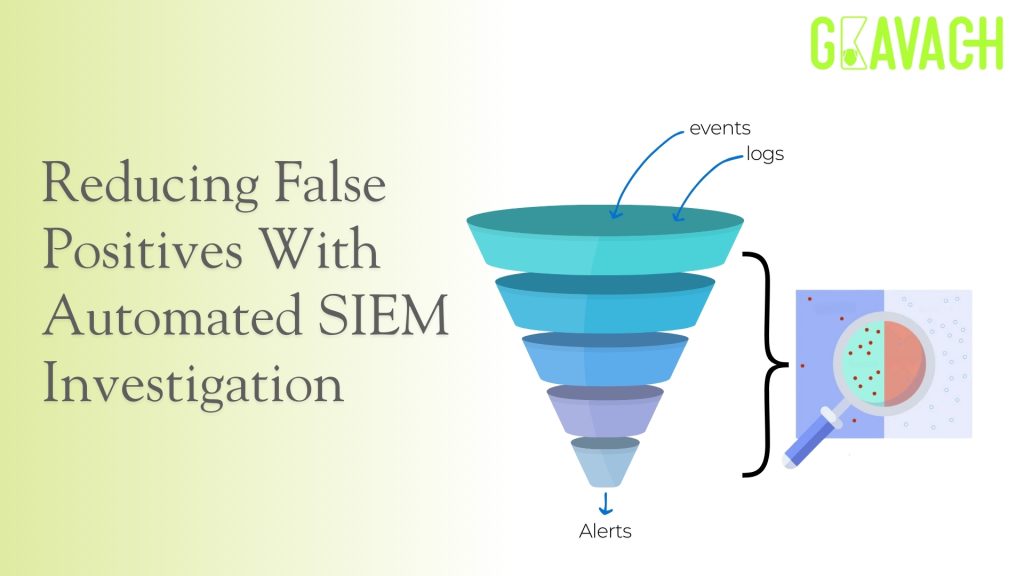
False positives in SIEM solutions are a significant challenge for security analysts. The high volume of alerts, many of which turn out to be non-threats, creates a substantial burden. This is not just inefficient – it is a potential security risk. When analysts are overwhelmed with false alarms, there is a real danger of overlooking genuine threats.
Automated SIEM investigation offers a solution to this problem. It acts as an efficient filter, separating actual threats from false alarms. Here’s how it is improving security operations:
Intelligent Alert Triage
Automated solutions rapidly evaluate incoming alerts using predefined rules and machine learning. This creates an effective initial screening process that identifies potential false positives before they reach human analysts.
Contextual Analysis
These solutions do not examine alerts in isolation. They aggregate data from various network sources, providing a comprehensive view. An alert that appears harmless individually might be recognized as part of a larger threat pattern when viewed in context.
Continuous Learning
As these solutions process more alerts, their accuracy improves. Machine learning algorithms adapt to your specific environment, becoming more adept at distinguishing between normal activities and genuine anomalies.
Optimizing Analyst Time
By managing initial investigations automatically, these solutions allow human analysts to focus on complex threats and strategic planning. This optimizes the use of skilled personnel, directing their expertise where it is most needed.
Measurable Impact
The results are compelling. At GKavach, the SOC team implemented automated investigation for the SIEM alerts. They now automatically triage and close over 1000+ alerts per day without human intervention.
Implementing Automated Investigation
To reduce false positives effectively, you can consider these steps:
- Establish a Baseline: Understand what constitutes normal activity in your environment before attempting to identify anomalies.
- Incremental Implementation: Begin with common, low-risk alert types. Gradually expand to more complex scenarios as you gain confidence.
- Comprehensive Integration: Connect your automated system to multiple data sources for more accurate decision-making.
- Ongoing Refinement: Regularly review and adjust your automation rules based on performance metrics.
- Maintain Human Oversight: Automated systems should enhance, not replace, human analysts. Incorporate checkpoints for human review and intervention.
Advanced Techniques for Reducing False Positives
Improving Rule Creation and Tuning
Improving the creation and fine-tuning of rules is important for minimizing false positives in SIEM solution. The utilization of advanced technology can simplify the process of developing effective correlation rules and enhance the precision of threat detection.
Continuous Monitoring and Evaluation
Regular assessments of SIEM performance, threat detection capabilities, and incident response procedures are essential. By continuously monitoring and evaluating the SIEM solution in place, you can promptly identify and address false positives before they escalate into more serious security incidents.
Integrating Threat Intelligence
Feeding your SIEM with real-time threat indicators helps correlate suspicious activity with known malicious patterns. This enhances your ability to detect and respond faster. However, it is important to use threat intelligence judiciously, as it can be prone to false positives if used as a primary alerting mechanism.
Enhancing Context with Data Enrichment
Adding context to alerts is crucial for reducing false positives. This can be achieved by integrating SIEM with other data sources such as HR systems and asset management databases. For instance, understanding that a user logging into a production system is the CEO with appropriate access rights can prevent unnecessary escalation.
Challenges in Implementing Automated SIEM Investigation
While automated SIEM investigation offers significant benefits, it is not without challenges:
- Initial Setup Complexity: Configuring automated solutions to accurately distinguish between normal and suspicious behavior can be complex and time-consuming.
- Keeping Pace with Evolving Threats: As cyber threats evolve; automated solutions need continuous updates to remain effective.
- Balancing Automation and Human Insight: While automation can handle many tasks, human expertise remains crucial for complex investigations and strategic decision-making.
- Data Quality and Integration: The effectiveness of automated solutions relies heavily on the quality and comprehensiveness of the data they analyze.
Best Practices for Implementing Automated SIEM Investigation
- Define Clear Use Cases: Before diving into SIEM implementation or optimization, clearly define the specific security use cases and objectives for your organization.
- Collect Only What Matters: Focus on collecting and analyzing data that is truly relevant to your security posture. Avoid the temptation to log everything.
- Regular Training and Skill Development: Ensure your security team is well-trained on the SIEM system and stays updated on the latest threat detection techniques.
- Test and Validate: Regularly test your SIEM solution’s effectiveness through simulated attacks or red team exercises.
- Plan for Scalability: As your organization grows, ensure your SIEM solution can scale accordingly without compromising performance or accuracy.
The Future of SIEM and False Positive Reduction
As we look ahead, automation in SIEM investigation will become increasingly important. However, it is crucial to understand that this technology aims to support human analysts, not replace them. Automation handles routine tasks, allowing your team to concentrate on the strategic and complex aspects of cybersecurity that require human insight.
Conclusion
Reducing false positives in SIEM solutions is about more than just efficiency – it is about improving overall security effectiveness. It ensures that when genuine threats emerge, your team is prepared and not distracted by unnecessary alerts. In the critical field of cybersecurity, this improved focus can be a decisive factor.
Automated SIEM investigation represents a current best practice, not just a future possibility. In an environment where rapid threat detection and response are crucial, organizations must consider implementing these improvements to stay ahead of evolving cyber threats and protect their critical assets effectively.
By leveraging advanced technologies, implementing automated workflows, and following best practices, organizations can significantly reduce the noise in their security operations. This not only improves the efficiency of security teams but also enhances their ability to detect and respond (Mean Time To Detect and Mean Time To Response) to genuine threats promptly, ultimately strengthening their overall cybersecurity posture.